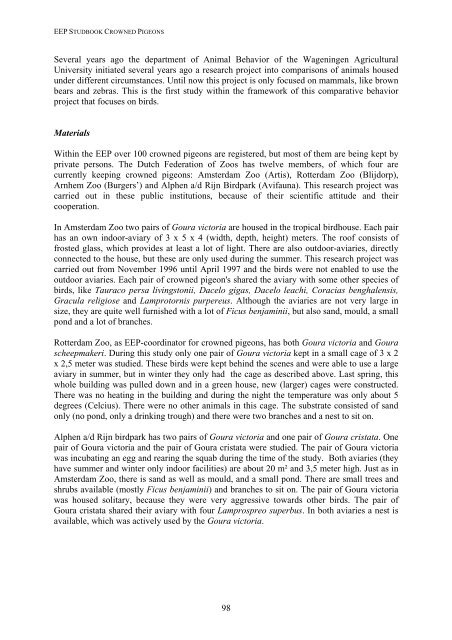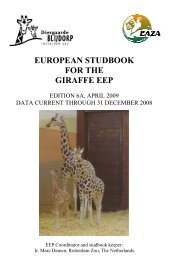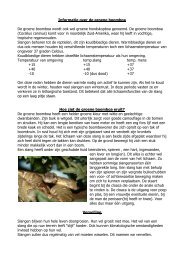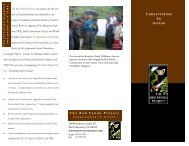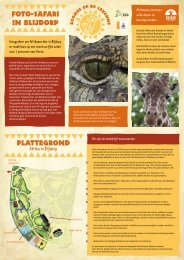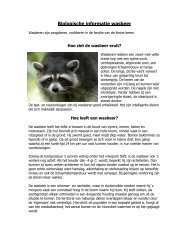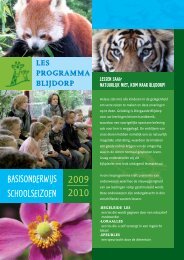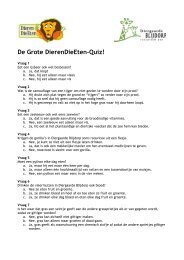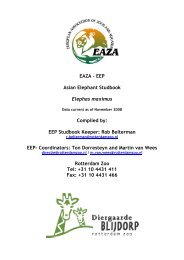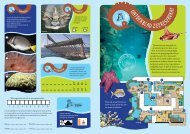You also want an ePaper? Increase the reach of your titles
YUMPU automatically turns print PDFs into web optimized ePapers that Google loves.
<strong>EEP</strong> STUDBOOK CROWNED PIGEONS<br />
Several years ago the department of Animal Behavior of the Wageningen Agricultural<br />
University initiated several years ago a research project into comparisons of animals housed<br />
under different circumstances. Until now this project is only focused on mammals, like brown<br />
bears and zebras. This is the first study within the framework of this comparative behavior<br />
project that focuses on birds.<br />
Materials<br />
Within the <strong>EEP</strong> over 100 crowned <strong>pigeon</strong>s are registered, but most of them are being kept by<br />
private persons. The Dutch Federation of Zoos has twelve members, of which four are<br />
currently keeping crowned <strong>pigeon</strong>s: Amsterdam Zoo (Artis), Rotterdam Zoo (Blijdorp),<br />
Arnhem Zoo (Burgers’) and Alphen a/d Rijn Birdpark (Avifauna). This research project was<br />
carried out in these public institutions, because of their scientific attitude and their<br />
cooperation.<br />
In Amsterdam Zoo two pairs of Goura victoria are housed in the tropical birdhouse. Each pair<br />
has an own indoor-aviary of 3 x 5 x 4 (width, depth, height) meters. The roof consists of<br />
frosted glass, which provides at least a lot of light. There are also outdoor-aviaries, directly<br />
connected to the house, but these are only used during the summer. This research project was<br />
carried out from November 1996 until April 1997 and the birds were not enabled to use the<br />
outdoor aviaries. Each pair of crowned <strong>pigeon</strong>'s shared the aviary with some other species of<br />
birds, like Tauraco persa livingstonii, Dacelo gigas, Dacelo leachi, Coracias benghalensis,<br />
Gracula religiose and Lamprotornis purpereus. Although the aviaries are not very large in<br />
size, they are quite well furnished with a lot of Ficus benjaminii, but also sand, mould, a small<br />
pond and a lot of branches.<br />
Rotterdam Zoo, as <strong>EEP</strong>-coordinator for crowned <strong>pigeon</strong>s, has both Goura victoria and Goura<br />
scheepmakeri. During this study only one pair of Goura victoria kept in a small cage of 3 x 2<br />
x 2,5 meter was studied. These birds were kept behind the scenes and were able to use a large<br />
aviary in summer, but in winter they only had the cage as described above. Last spring, this<br />
whole building was pulled down and in a green house, new (larger) cages were constructed.<br />
There was no heating in the building and during the night the temperature was only about 5<br />
degrees (Celcius). There were no other animals in this cage. The substrate consisted of sand<br />
only (no pond, only a drinking trough) and there were two branches and a nest to sit on.<br />
Alphen a/d Rijn birdpark has two pairs of Goura victoria and one pair of Goura cristata. One<br />
pair of Goura victoria and the pair of Goura cristata were studied. The pair of Goura victoria<br />
was incubating an egg and rearing the squab during the time of the study. Both aviaries (they<br />
have summer and winter only indoor facilities) are about 20 m² and 3,5 meter high. Just as in<br />
Amsterdam Zoo, there is sand as well as mould, and a small pond. There are small trees and<br />
shrubs available (mostly Ficus benjaminii) and branches to sit on. The pair of Goura victoria<br />
was housed solitary, because they were very aggressive towards other birds. The pair of<br />
Goura cristata shared their aviary with four Lamprospreo superbus. In both aviaries a nest is<br />
available, which was actively used by the Goura victoria.<br />
98


